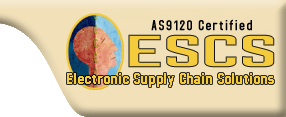 Aerospace professionals know the old ways just don't cut it.
Aerospace professionals know the old ways just don't cut it.
Virtually all aerospace and military prime contractors are developing new procurement
strategies to mitigate counterfeit risks while still maintaining flexibility and cost-effectiveness.
As a Quality Manager, it's up to you to recommend and then implement those strategies, and unfortunately,
there is no single tactic or set of policy changes that will be appropriate for every company. There
is no substitute for doing the business process analysis needed to create an optimal solution for your company.
If you are tasked with developing a risk mitigation strategy, the below topic areas present a
framework for achieving that goal. If you're already well along in the process, use it as a "checklist"
for process evaluation.
|
|
Step 1: The Scope of the Problem - Get the Facts
|
Getting the facts means understanding both the external environment and your company's internal situation.
External Environment
If you're not already up to speed, do some basic research. CombatCounterfeits.com
has a wealth of resources and links to useful information, so fully investigate the content
on this site. We think the best overview of what's really going on can be found in Business Week's
investigative report,
"Dangerous Fakes".
For a peek at what's happening with other companies, Electronic Supply Chain Solutions, Inc. completed an
industry assessment
in October, 2008 that for the first time shed light on the impact of increased counterfeits on the prime contractors
and what they are actually doing to combat counterfeits.
Internal Situation
You may already be painfully aware of the impact of counterfeits on your own supply chain. If not, consider
yourself fortunate; but don't assume you haven't been impacted. There is a high likelyhood there are
counterfeit components you are not aware of in the products already delivered to your customers! They just haven't
failed... yet.
Document known examples of counterfeits that have already been found in your supply chain.
Inspect QC hold samples of completed products, with an eye to finding counterfeit "cues". For examples, see
our section on "The Tricks They Play".
Inspect current component inventory and all records related to testing of components not sourced through
authorized franchise distributors.
Review existing inspection protocols, both inside your company and at all of your non-franchised suppliers.
If you've taken the above steps, what should you do from this point to mitigate risk going forward?
|
|
Step 2: Develop A Risk Mitigation Strategy
|
Your situation analysis should help you define the objectives of your strategy. The following
represent the basic elements of any counterfeit risk mitigation strategy. Every company should tailor
their strategy to best fit the unique nature of their operations.
Identify best practices in the industry. Use the resources on this site, and network through your
professional organizations.
Centralized or decentralized - Which approach is best for your company?
Vendor management - selection & control:
Set minimum quality criteria for distributors
(See ESCS's recommended criteria.)
Reduce total supplier base to a few, high-quality companies
Track and report supplier performance
Define component sourcing requirements for traceability, pedigree and testing
Define purchase order conditions for testing, and when that is required
|
|
Step 3: Gain Commitment to the Plan
|
Implementing your strategy requires the entire organization to get on board and make it happen. Every company
has a culture, and changes can be painful. No matter how good your strategy is, it won't be effective is you
don't truly have everyone pulling together to make it work.
Strategy should be reviewed and approved by the senior company officer responsible for procurement,
and formally endorsed by the president or CEO.
Hold education and training sessions with all supply chain quality and procurement staff on the project and specific expectations.
|
|
Step 4: Execute! (Plan, Do, Check, Act)
|
Like all complex organizational changes, clear objectives and management responsibility are absolutely essential.
Don't make the mistake of simply creating policy and expecting the required changes to happen without oversight.
Assign a single senior staff member with overall implementation responsibility, and the necessary authority
to set and execute policy.
Define clearly the implementation responsibilities for every member of the quality and procurement staff.
Set a project timetable for key implementation milestones and communicate that broadly
throughout the process.
|
|
Step 5: Manage Continuous Improvement
|
Once you have an effective policy in place, keep it current and ensure any issues are addressed as quickly
as possible.
Perform an annual counterfeit risk mitigation assessment to measure the effectiveness of current strategy
and perform a review of further developments within the industry, such as new certifications, testing standards, etc.
Incorporate zero tolerance supply metrics and adherence to risk mitigation policies in management
performance reviews and incentive compensation plans.
By following the above guidelines and tailoring your implementation to the specific operational structure of your
company, you will have the best chance of effective implementation. ESCS has consulted with many companies
on strategy development, and will be pleased to provide free consultation on any aspect of the process. Please
contact us to explore how we can help, or schedule a workshop to
cover a specific aspect of your risk mitigation strategy development process.
|
|
|
Who's Certifying Quality?
|
Not all ISO or Aerospace Registrars are equal. Confirm who has registered your distributors, and who is
performing their audits. This information is available for all AS9100 and AS9120 certified companies on the
OASIS database.
The registrar for ESCS is National Quality Assurance (NQA),
who are also the registrar for NASA and other top-tier companies, and can be highly recommended.
|
|
|
ISO 9001 vs. AS9120 - You Decide
|
Aerospace manufacturers must be certified to the Aerospace AS9100 standard - more stringent than the ISO 9001
standard for general manufacturing. For distributors, the AS9120 standard
flows down the manufacturer's AS9100 requirements for inventory control, lot tracing and vendor management,
ensuring manufacturers have consistency throughout their supply chain.
You may feel it's commendable to see your distributors have achieved an ISO 9001 certification, and it is...
but it's up to you to decide if you can afford NOT to flow down your critical parts control to your suppliers.
|
|
|
Compliant vs. Certified
|
This one's easy! Beware the supplier who promotes they are "ISO 9001 compliant" or
"AS9120 compliant". According to whom?
Anyone can buy a box of documents and put their company name on the binder.
If they are truly operating to the standard, why not simply schedule a certification audit?
|
|
|
Quality Certificates - What's Important
|
Ask your distributors for a copy of their most recent ISO 9001 or AS9120 certificate.
What you should check:
Initial registration date
Certificate expiration date
Date of last surveillance audit
For ISO 9001 companies, annually ask for the results of their last surveillance audit, and
for AS9120 companies, annually check the OASIS database
to see their audit results.
Click here to view ESCS's AS9120 certificate
as an example.
|
|



